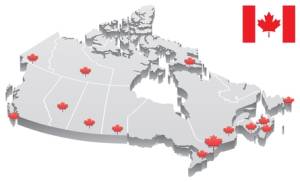 If you’re considering becoming a Licensed Practical Nurse (LPN) in Canada, your path will, for the most part, be similar to the one taken by your U.S. counterparts.
If you’re considering becoming a Licensed Practical Nurse (LPN) in Canada, your path will, for the most part, be similar to the one taken by your U.S. counterparts.
Nonetheless, there are several differences that you should be aware of. This guide will cover the key points and provide you with a step-by-step guide to gaining licensure in Canada.
About Practical Nursing in Canada
Practical nursing (i.e. LPN) is one of three types of nursing groups regulated at the national level, along with Registered Nurses (RNs) and Registered Psychiatric Nurses (RPN). The national overseeing body for this group is the Canadian Council for Practical Nurse Regulators (CCPNR), which is responsible for supporting the growth and standardization of processes and guidelines for Licensed Practical Nurses in all 10 Canadian provinces and the territories.
Becoming a Licensed Practical Nurse in Canada
There are four main steps required to become a Licensed Practical Nurse in Canada. In the order they must be completed, these are:
- Complete the written and verbal nursing and language exams required for admission to your program
- Undergo an evaluation of your practical nursing skills and educational background through the appropriate provincial regulator (see above)
- Pass a criminal background check and a screening for past disciplinary actions if you previously worked as an LPN elsewhere
- Complete the required number of training hours and pass the Canadian Practical Nurse Registration Examination (CPNRE)
It should be pointed out that residents of Quebec will have slightly different requirements for the CPNRE and certain provincial prerequisites. To review these in detail, please visit the website for the Ordre des infirmieres et infirmiers auxiliaires du Quebec.
 LPN Programs by Province
LPN Programs by Province
When choosing an LPN program in Canada, it is imperative that you look for accreditation by the appropriate provincial regulating body. In order to make this process easier, we have provided the following resource pages which include contact information for all regionally-accredited practical nursing programs in each province.
[shadow_box width=”100%”]
[two_columns_1]
LPN Programs in Alberta
LPN Programs in B.C.
LPN Programs in Manitoba
LPN Programs in New Brunswick
LPN Programs in Newfoundland
[/two_columns_1] [two_columns_2]
LPN Programs in Nova Scotia
LPN Programs in Ontario
LPN Programs on P.E.I.
LPN Programs in Quebec
LPN Programs in Saskatchewan
[/two_columns_2]
[/shadow_box]
Provincial Requirements
Most provinces have their own unique educational and employment requirements for practical nursing professionals in addition to those spelled-out by the CCPNR.
To find out about the specific requirements in your province, we’ve provided the following list of the main provincial regulators across Canada:
[shadow_box width=”100%”]
[two_columns_1]
Alberta – CLPNA
British Columbia – CLPNBC
Manitoba – CLPNM
New Brunswick – ANBLPN
Newfoundland – CLPNNL
[/two_columns_1] [two_columns_2]
Nova Scotia – CLPNNS
Ontario – CNO
Prince Edward Island – LPNA
Quebec – OIIAQ
Saskatchewan – SALPN
[/two_columns_2]
[/shadow_box]
The Canadian Practical Nurse Registration Examination (CPNRE)
The final step in becoming an LPN in any Canadian province is passing the Canadian Practical Nurse Registration Examination, or CPNRE. The exam itself is made-up of seven different sections – each of which tests for entry-level competency in a specific discipline of the practical nursing profession.
The following sections are contained within the CPNRE:
- Professional Competencies
- Ethical Issues
- Understanding of Legal Obligations
- Patient Assessment
- Planning & Implementation of Treatments
- Evaluation of Ongoing Treatments
- Collaborative Practice
Test Format
The CPNRE is administered at test centers across the country affiliated with Assessment Strategies Inc. and generally consists of 180 to 200 multiple-choice questions. The examination is timed, and students are given a total of four hours to complete their work.
Passing the Exam
The exam is scored solely on a “pass-fail” basis where those students who post a score above the minimum threshold are notified that they have passed, and those who scored below the threshold are notified that they have failed. Students who fail the exam are eligible to retake it, and may also challenge the results through an appeals process with their local regulatory authority if they feel that a mistake has been made.
Becoming an LPN in Canada
Nonetheless, there are several differences that you should be aware of. This guide will cover the key points and provide you with a step-by-step guide to gaining licensure in Canada.
About Practical Nursing in Canada
Practical nursing (i.e. LPN) is one of three types of nursing groups regulated at the national level, along with Registered Nurses (RNs) and Registered Psychiatric Nurses (RPN). The national overseeing body for this group is the Canadian Council for Practical Nurse Regulators (CCPNR), which is responsible for supporting the growth and standardization of processes and guidelines for Licensed Practical Nurses in all 10 Canadian provinces and the territories.
Becoming a Licensed Practical Nurse in Canada
There are four main steps required to become a Licensed Practical Nurse in Canada. In the order they must be completed, these are:
It should be pointed out that residents of Quebec will have slightly different requirements for the CPNRE and certain provincial prerequisites. To review these in detail, please visit the website for the Ordre des infirmieres et infirmiers auxiliaires du Quebec.
When choosing an LPN program in Canada, it is imperative that you look for accreditation by the appropriate provincial regulating body. In order to make this process easier, we have provided the following resource pages which include contact information for all regionally-accredited practical nursing programs in each province.
[shadow_box width=”100%”]
[two_columns_1]
LPN Programs in Alberta
LPN Programs in B.C.
LPN Programs in Manitoba
LPN Programs in New Brunswick
LPN Programs in Newfoundland
[/two_columns_1] [two_columns_2]
LPN Programs in Nova Scotia
LPN Programs in Ontario
LPN Programs on P.E.I.
LPN Programs in Quebec
LPN Programs in Saskatchewan
[/two_columns_2]
[/shadow_box]
Provincial Requirements
Most provinces have their own unique educational and employment requirements for practical nursing professionals in addition to those spelled-out by the CCPNR.
To find out about the specific requirements in your province, we’ve provided the following list of the main provincial regulators across Canada:
[shadow_box width=”100%”]
[two_columns_1]
Alberta – CLPNA
British Columbia – CLPNBC
Manitoba – CLPNM
New Brunswick – ANBLPN
Newfoundland – CLPNNL
[/two_columns_1] [two_columns_2]
Nova Scotia – CLPNNS
Ontario – CNO
Prince Edward Island – LPNA
Quebec – OIIAQ
Saskatchewan – SALPN
[/two_columns_2]
[/shadow_box]
The Canadian Practical Nurse Registration Examination (CPNRE)
The final step in becoming an LPN in any Canadian province is passing the Canadian Practical Nurse Registration Examination, or CPNRE. The exam itself is made-up of seven different sections – each of which tests for entry-level competency in a specific discipline of the practical nursing profession.
The following sections are contained within the CPNRE:
Test Format
The CPNRE is administered at test centers across the country affiliated with Assessment Strategies Inc. and generally consists of 180 to 200 multiple-choice questions. The examination is timed, and students are given a total of four hours to complete their work.
Passing the Exam
The exam is scored solely on a “pass-fail” basis where those students who post a score above the minimum threshold are notified that they have passed, and those who scored below the threshold are notified that they have failed. Students who fail the exam are eligible to retake it, and may also challenge the results through an appeals process with their local regulatory authority if they feel that a mistake has been made.